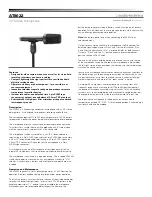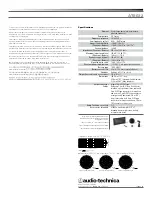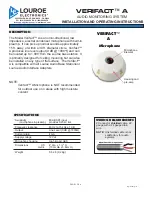
broadcast & production
microphones
AT8022
X/Y Stereo Microphone
Features
• Designed for video camera-mount use as well as for stereo field
recording, interviews and home recording
• Compact, lightweight design is perfect for use with handheld
digital recording devices
• Operates on battery or phantom power—for use with pro or
consumer equipment
• Innovative coincident capsule configuration produces accurate
stereo image in smaller housing
• Includes two cables: one balanced (two 3-pin XLRM-type
connectors at output); one unbalanced (3.5 mm TRS at output)
• Switchable 80 Hz high-pass filter minimizes pickup of undesired
low-frequency sounds
Description
The AT8022 is a fixed-charge condenser microphone with an X/Y stereo
polar pattern. It is designed for broadcast, recording and field use.
The microphone requires 11V to 52V phantom power or a 1.5V AA battery
for operation. A battery need not be in place for phantom power operation.
The microphone offers an innovative coincident capsule configuration.
This allows for a smaller housing while producing an X/Y stereo image
with the spatial impact and realism of a live sound field.
The microphone includes two cables: a 2 m (6.5') balanced cable
terminating in a 5-pin XLRF-type and two 3-pin XLRM-type connectors;
a 0.6 m (2') unbalanced cable terminating in a 5-pin XLRF-type and a
3.5 mm TRS connectors. The output of the microphone is a 5-pin
XLRM-type connector.
A switch permits choice of flat response or low-frequency roll-off (via
integral 80 Hz high-pass filter) to help control undesired ambient noise.
The microphone is enclosed in a rugged housing. The included AT8405a
stand clamp permits mounting on any microphone stand with
5
/
8
"-27
threads. A windscreen, a battery and a soft protective pouch are also
included.
Operation and Maintenance
The AT8022 requires 11V to 52V phantom power or a 1.5V AA battery for
operation. A battery need not be in place for phantom power operation.
To install the battery, unscrew the lower section of the microphone body
to reveal the battery compartment. Insert a fresh 1.5V AA battery in the
handle compartment (“+” end up), then reassemble the microphone.
Alkaline batteries are recommended for longest life. Remove the
battery during long-term storage. Battery switch must be on for battery
operation. Turn off when not in use to preserve battery life. Battery switch
has no effect on phantom power operation.
Note:
Use battery power only when connecting the AT8022 to an
unbalanced input.
Output for each stereo channel is low impedance (Lo-Z) balanced. The
balanced signals appear across Pins 2 and 3 for the left channel, Pins
4 and 5 for the right channel. Pin 1 is ground (shield) for both channels.
Output is “Pins 2 and 4 hot”— positive acoustic pressure produces
positive voltage at Pins 2 and 4.
The end of the grille should be aimed at the sound source with the top
of the microphone facing up (the top of the microphone is indicated by
the left-right stereo image printed on the housing), so the stereo image
matches the sound source.
Locating the microphone nearer the sound source enhances the width of
the stereo image, while decreasing room ambience. Conversely, as the
mic position moves away from the sound source, a narrower left/right
stereo image results and more of the “room sound” is noted.
An integral 80 Hz high-pass filter provides easy switching from a flat
frequency response to a low-end roll-off. The roll-off position reduces
the pickup of low-frequency ambient noise (such as traffic, air-handling
systems, etc.), room reverberation and mechanically coupled vibrations.
To engage the high-pass filter, slide the switch toward to “bent” line.
Avoid leaving the microphone in the open sun or in areas where
temperatures exceed 110° F (43° C) for extended periods. Extremely high
humidity should also be avoided.




















